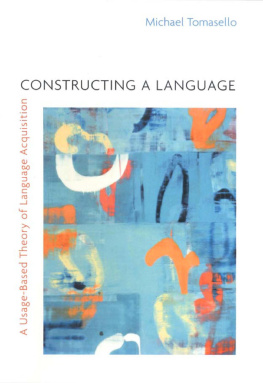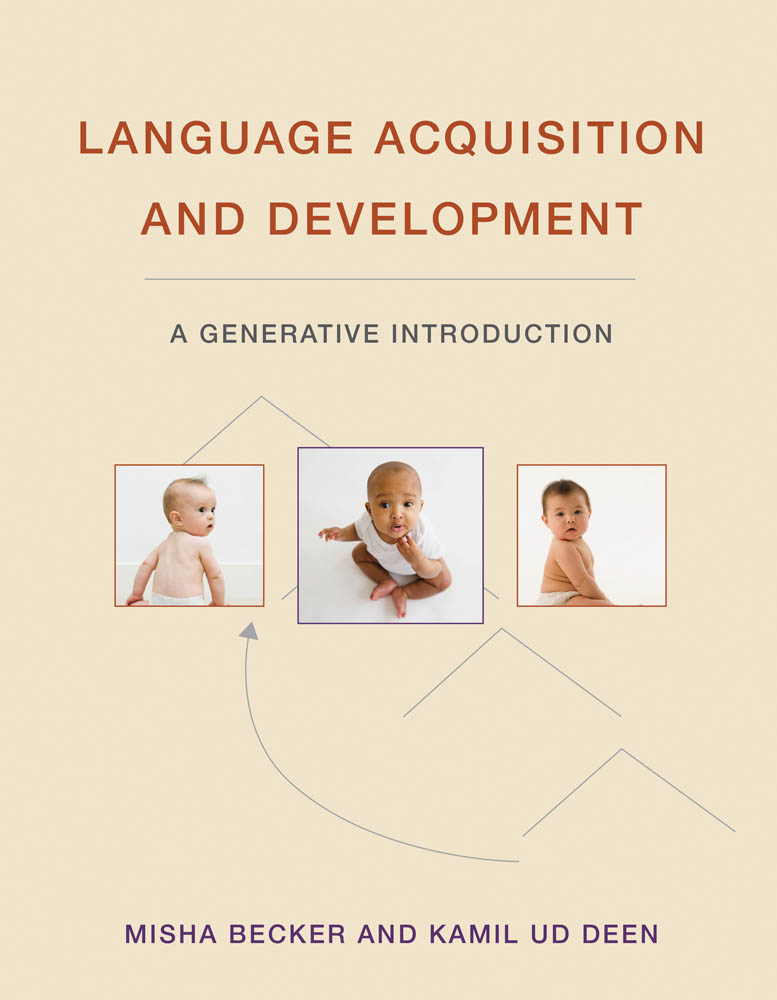All rights reserved. No part of this book may be reproduced in any form by any electronic or mechanical means (including photocopying, recording, or information storage and retrieval) without permission in writing from the publisher.
Names: Becker, Misha Karen, 1973- author. | Ud Deen, Kamil, author.
Title: Language acquisition and development : a generative introduction / Misha Becker, Kamil Ud Deen.
Description: Cambridge : MIT Press, 2020. | Includes bibliographical references and index.
Subjects: LCSH: Language acquisition. | Children--Language. | Communicative competence in children.
Contents
List of Illustrations
Linear vs. hierarchical sentence structure.
A common optical illusion. The horizontal lines dont look parallel (but they are). The black and white are not aligned, but our eyes naturally follow the vertical lines and compensate for the unevenness by interpreting the horizontal lines as sloping.
Words are drawn from the lexicon and fed into the computational unit, which then applies various procedures to produce the output sentence.
Illustration of transitional probabilities within vs. between words in an artificial language.
If children are unbiased learners, and if the initial hypothesis is based on linear order, subsequent data should result in strong entrenchment of that hypothesis, such that any recalcitrant data will be preempted.
A waveform (upper half) and spectrogram (lower half) of the English words cat, sat, bat, that, pat. The spectrogram shows the component frequencies, with peaks of intensity shown by dark bands. The waveform shows the amplitudes (loudness) of the sound waves (a bigger wave means a larger amplitude, which means a louder sound).
This waveform and spectrogram depict the same recording shown in figure 3.1, but with all frequencies above 1000 Hz removed and replaced with white space. Notice how much of the information in the spectrogram is missing.
The VOT timeline marked off in 10 ms increments. The point marked 0 indicates the moment of release of the consonant. The three potential categories that languages may distinguish in terms of VOT are labeled with their phonetic voicing values of voiced, plain, or aspirated.
For English speakers, the + 25 ms mark is the boundary between sounds perceived as /b/ and sounds perceived as /p/.
Illustration of the stimuli used by Eimas et al. (1971) to determine whether infants perceived stop consonants categorically.
A spectrogram depicting the sentence This is a spectrogram demonstration.
The basic structure of a syllable.
Illustration of adult and infant vocal tracts. (From Kent and Miolo 1995. Reproduced with permission.)
Basic structures for verbs and the participants in their events.
Types of morphemes found in English.
Hypothetical graph of childs production of third-person-singular -s in obligatory contexts.
.)
Hypothetical U-shaped development.
Contrastive features in ASL. a, Signs contrast in hand shape. b, Signs contrast in place of articulation (location). c, Signs contrast in movement. Image reprinted with permission from Poizner, Howard, Edward Klima, and Ursula Bellugi, What the Hands Reveal about the Brain (Cambridge, MA: MIT Press, 1987), p. 4, fig. 1.1.
).
Left: Longitudinal data: few participants, but many data collection points across time. Right: Cross-sectional data: many participants with data collected at one time point each.
.
Left: Picture to elicit subject wh-questions. Right: Picture to elicit object wh-questions.
Picture selection task: Which picture shows banana?
The intermodal preferential looking paradigm setup. From Hirsh-Pasek and Golinkoff (1996). Reprinted with permission.
Measuring habituation using heart rate.
List of Tables
Training and test items used by Marcus et al. (1999)
Examples of form-meaning pairings
Five-stage process to abstract schema formation
Experimental stimuli in Eimas et al. (1971)
Target language contrasts perceived by English-acquiring infants by 6 months
Nontarget language contrasts perceived by English-acquiring infants by 6 months
Predominant vocalizations of 1-year-olds
Examples of childrens substitution phonological processes
Examples of childrens assimilation phonological processes
Examples of childrens syllabic phonological processes
Crosslinguistic substitution patterns
Ages of children and the average (median) number of words produced, with range of words in parentheses, where provided
Markman and Wachtels (1988) experimental design
Example dialogue
Percentage of selection of original object (results for girls)
Hypothetical data set of a childs production of third-person-singular -s in obligatory contexts
Order of acquisition of fourteen morphemes, and average ranks
Rate of agreement commission errors in a range of languages
Some functional categories in English, with examples
Tenses and their meanings
Placement of finite and nonfinite verbs with respect to negation (Pierce, 1989, 1992)
Summary of Crismas (1992) finding that OIs do not occur with wh-questions
Types of passive constructions
Results of Chien and Wexlers (1990) study
Sources for crosslinguistic features of SLI
Selected languages and their relative level of endangerment
List of Sidebars
:Different Kinds of Negative Evidence
:Induction and Universal Grammar
:More Input Does Not Help!
:Filtered Sounds
:Square versus Angled Brackets
:Finding Word Boundaries
:Differences in Varieties of Speech
:Infant-Directed Signing
:What Infant Speech Sounds Like
:Changes in Infant Speech
:Markedness
:Phonological Processes
:Imitating Mom
:Why Do Children Overextend?
:The Structured Lexicon
:Two Additional Principles of Word Learning
:Meanings of Most Common Verbs in English
:Gender Differences in Katz et al. (1974)
:Obligatory Contexts
:Rules for Calculating MLU
:Overregularization
:Counting Morphemes in English
:Semantic vs. Syntactic Bootstrapping
:X-bar Structures
:Looking for Functional Categories
:Summary of Truncation Hypothesis
:The Bare VP Hypothesis
:Null Subject Explanations
:Importance of Questions
:Kinds of Relative Clauses
:Animacy and Relative Clauses
:The Binding Principles
:What Genie Tells Us about the Brain
:Sign versus Spoken Language
:Lips as Cues to Speech
:Effects of SLI
:Theory of Mind and Language
Acknowledgments
The idea for this book was born where many great ideas are bornduring a heady coffee break at the Boston University Conference on Language Development. We were comparing notes on how we teach introductory acquisition courses, and we were both struck by the paucity of textbooks that address child language acquisition, framed within generativist linguistic theory, and aimed at students who have relatively little background in linguistics. We resolved to develop our own textbook, and several years later, here we are. But in many ways the roots of this book should be traced back to our graduate school days. We were both students of Nina Hyamsscholar, leader, and mentor extraordinaire. It was Ninas sage guidance and teaching, along with truly compelling subject matter, that hooked us. Under her tutelage we developed our passion for studying how children create grammars and our desire to share that passion with others. We gratefully dedicate this book to Nina, in appreciation of all she has done for her students, the field of linguistics, and the field of language acquisition. She has made an indelible mark, both on us as scholars and, more importantly, on the field as a whole.








